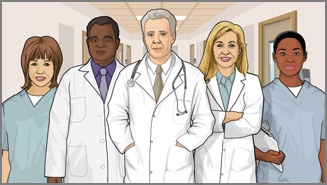- Bathing a patient in bed
- Benefits of breastfeeding
- Bleeding during cancer treatment
- Blood transfusions
- Bringing your child to visit a very ill sibling
- Central venous catheter - dressing change
- Central venous catheter - flushing
- Cervical cancer - screening and prevention
- Changing your ostomy pouch
- Changing your urostomy pouch
- Children and grief
- Choosing a skilled nursing and rehabilitation facility
- Clear liquid diet
- Closed suction drain with bulb
- Deep breathing after surgery
- Diet and eating after esophagectomy
- Drawing medicine out of a vial
- Drinking water safely during cancer treatment
- Dry mouth during cancer treatment
- Eating extra calories when sick - adults
- Eating extra calories when sick - children
- Enteral nutrition - child - managing problems
- Full liquid diet
- Gastrostomy feeding tube - bolus
- Getting out of bed after surgery
- Getting your home ready - after the hospital
- Health risks of alcohol use
- Health risks of obesity
- Hemovac drain
- Home health care
- How to care for pressure sores
- How to choose a health plan
- How to stop smoking: Dealing with a slip up
- How to stop smoking: Dealing with cravings
- Ileostomy - caring for your stoma
- Ileostomy - changing your pouch
- Ileostomy and your diet
- Indwelling catheter care
- Jejunostomy feeding tube
- Living with your ileostomy
- Lymphedema - self-care
- Make the most of your doctor visit
- Managing your weight with healthy eating
- Mediterranean diet
- Moving a patient from bed to a wheelchair
- Myths about drinking alcohol
- Nasogastric feeding tube
- Oral mucositis - self-care
- Oxygen safety
- Pain and your emotions
- Palliative care - fluid, food, and digestion
- Palliative care - managing pain
- Peripherally inserted central catheter - flushing
- Portion size
- Postural drainage
- Preventing pressure ulcers
- Pulling a patient up in bed
- Radiation therapy - skin care
- Safe eating during cancer treatment
- Self catheterization - female
- Self catheterization - male
- Skilled nursing or rehabilitation facilities
- Skin lesion removal - aftercare
- Smoking and surgery
- Sterile technique
- Storing your medicines
- Sun protection
- Suprapubic catheter care
- Surgical wound care - closed
- Surgical wound care - open
- Swallowing problems
- Taking medicine at home - create a routine
- Tests and visits before surgery
- The day of surgery for your child
- The day of your surgery - adult
- The night before your surgery
- Total parenteral nutrition
- Tracheostomy care
- Tracheostomy tube - eating
- Tracheostomy tube - speaking
- Turning patients over in bed
- Types of ileostomy
- Urine drainage bags
- Urostomy - stoma and skin care
- Urostomy pouches and supplies
- Using an incentive spirometer
- Using oxygen at home
- Weight gain after quitting smoking: What to do
- Wet-to-dry dressing changes
- When you have diarrhea
- When you have nausea and vomiting
Health exams for: #AGEGROUP#
The following exams, tests, and procedures are recommended for #AGEGROUPLOWER#.#FEMALETEXT#
Select a link from the list below to learn how and why each test is performed, as well how to prepare for it.
Exam
Frequency
© 1997-
 All rights reserved.
All rights reserved.
 All rights reserved.
All rights reserved.
A.D.A.M. content is best viewed in IE9 or above, Firefox and Google Chrome browsers.
The information provided herein should not be used during any medical emergency or for the diagnosis or treatment of any medical condition. A licensed medical professional should be consulted for diagnosis and treatment of any and all medical conditions. Links to other sites are provided for information only -- they do not constitute endorsements of those other sites. No warranty of any kind, either expressed or implied, is made as to the accuracy, reliability, timeliness, or correctness of any translations made by a third-party service of the information provided herein into any other language. © 1997-
A.D.A.M., a business unit of Ebix, Inc. Any duplication or distribution of the information contained herein is strictly prohibited.


